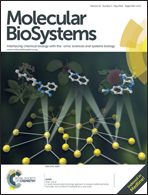Characterization of secreted vesicles from vascular smooth muscle cells†
Abstract
The artery medial layer is mainly composed of vascular smooth muscle cells (VSMCs). These cells contribute to the formation of neointima and atherosclerotic plaques by switching from the quiescent-contractile to migratory-activated state. Apoptotic blebs, microvesicles and exosomes are secreted vesicles, with differences in composition and size, involved in cellular communication at multiple levels. In this article, an untargeted, proteomics approach was exploited to characterise VSMC released vesicles and a preliminary protein profile for microvesicles and exosomes of different cell phenotypes was obtained. Enriched samples of vesicles from serum-free and serum-activated VSMCs were analysed by a LC-MS/MS strategy leading to the identification of 349 proteins. In microvesicles, the most abundant classes of identified proteins were cytoplasmic or organelle associated, house keeping and metabolic factors. Otherwise, exosomes from different phenotypes revealed a sharper peculiarity thus, as suggested by the high percentage of ECM and ECM related proteins and cell adhesion molecules, they seem to play an important role in outward or cell-to-cell signalling. Comparison between exosomes or microvesicles from quiescent and activated VSMCs evidenced 29 differentially expressed proteins. Among these, in microvesicles there are several proteins that are involved in vesicle trafficking while in exosomes focal adhesion and ECM related factors are the most interesting. These data, although preliminary, are promising for a possible identification of potential circulating markers of a cell state.


 Please wait while we load your content...
Please wait while we load your content...